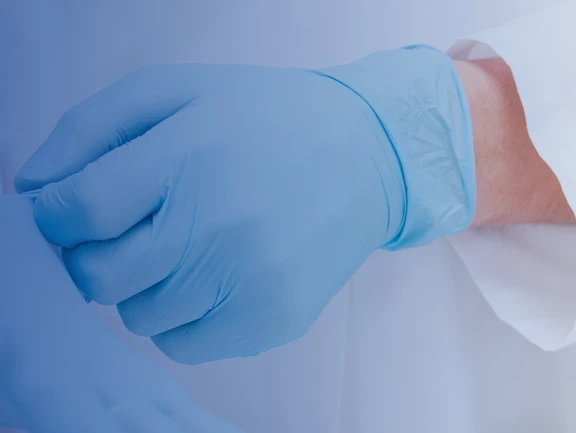Consumables and accessories: Essential medical disposables
Disposable items are used in greater numbers in medicine than practically anywhere else. Although the general trend is clearly moving in the direction of reusable products, there are simply no reusable solutions for many products in medicine.
Hygiene is the top priority in medicine. Only by working absolutely clean and sterilizing all instruments and materials can it be prevented that the patient is worse off after a treatment than before due to infections. This applies in particular to procedures that inevitably breach the body's natural infection barriers such as the skin or mucous membranes. Infectious pathogens do not usually remain in one place; they multiply and spread in different ways on objects, in liquid media and in the room air, especially via ventilation systems. Surgical instruments made of stainless steel are generally easy to clean and sterilize and are therefore rarely disposable. The situation is different for plastic products. Gloves, face masks, bandages and syringes are just a few examples of materials that cannot be thermally disinfected without melting during the process. Some products for which there are reusable alternatives, such as Petri dishes or gowns, are nevertheless rarely used. This is not exclusively due to the fact that disposable products are cheaper, although this is also often the case. Patient safety is the top priority and the respective hygiene and risk management departments must have considerable financial and human resources at their disposal to take on the additional effort and bear the costs. If disposable items are not used, there are also various additional sources of danger for staff, for example when transporting infectious hazardous goods alone. In addition, every sterilization measure has to be documented at great expense and every batch has to be checked. The additional work involved in maintaining and caring for the devices, as well as the necessary validation of the procedures, means that disposable items are preferred in most cases.
Consumables - from sterile goods to hazardous waste in seconds
Every day, German hospitals produce a total of around seven to eight tons of waste, an average of six kilograms per patient per day. A large proportion of this is packaging that protects sterile, individually packaged disposable items from contamination until they are used. Of course, the disposable items themselves also have a considerable weight and volume. They can also be contaminated with pathogens after use and are therefore declared hazardous waste.
Gloves are among the most frequently used disposable items. The disposable glove protects both patients and staff from the transmission of infectious agents. In the case of puncture wounds, they increase the likelihood of no or at least fewer pathogens entering the bloodstream directly. Finally, they also improve attention; people automatically pay more attention to their hands. With gloved hands, fewer things are touched involuntarily or accidentally. Employees in the medical field whose skin barrier is weakened by too much disinfectant and too little moisturizing through skin care must inevitably use gloves.
Syringes and cannulas also account for a significant proportion of waste. The fact that they are used to introduce active ingredients under the skin or into the muscle means that no compromises can be made with regard to sterility. A needle that has been used once on the ampoule is already too blunt to be reused. Furthermore, cleaning is inconceivable due to the many small cavities.
Plasters and other dressing materials come into direct contact with the patient's blood and are changed frequently. Reprocessing in the hospital is not possible here either. Protective clothing such as disposable gowns and face masks are mainly worn during operations or in the presence of immunocompromised patients. Even if cotton gowns are used that are sterilized by boil washing, they would still have to be packed in sterile plastic bags until they are used.
Effective and environmentally friendly management of medical consumables
Even if replacing disposable items with reusable items is often not an option, waste can be avoided and costs reduced through well thought-out organization. Recycling is one way of doing this. Hospitals can work directly with recycling companies, which may at least take the separately collected, non-hazardous plastic waste free of charge and recycle it in the best possible way.
A large amount of waste can also be avoided through planning, organization and intelligent design of workstations and patient rooms. An additional glove dispenser at each point of use not only prevents the glove boxes from mysteriously disappearing from the shelf or drawer and then having to be searched for, but also prevents an extra pair from being needed because another object was touched on the way - even if it is just a door handle. It also makes sense to place gloves in all available sizes clearly visible on holders for wall mounting. Gloves can be removed from a glove dispenser on the wall with one hand, whereas a box on the table usually has to be held with one hand - especially when the supply is running low.
Waste collectors should also never be skimped on. Any transportation of potentially infectious material is a risk for the employee. A variation of different containers for all waste categories creates a tidy and pleasant to use work area. It is therefore also worth going beyond the legally required minimum for waste collectors. Waste garbage cans are generally placed less on wall-mounted brackets. Collection systems attached to standard rails near the patient are popular.
Buschmeier Medizintechnik - We help to optimize consumption and benefits
Optimized equipment can achieve many positive results for staff, patients and the environment. Our single to triple glove holders will always be where a glove dispenser is needed. If the space is rather small, the suitable wall-mounted holders can be an option. If the disposable glove is to be available on the move, a model for attachment to the support tube of an equipment trolley is recommended. However, the glove dispensers can also be easily mounted on standard rails of beds, couches or other furniture. Because the gloves must be disposed of immediately after use, waste bins should always be located in the immediate vicinity of the glove dispensers. In our product range you will find closed and open waste bag holders, which are often ordered together with the glove holders. If you have your own ideas, please do not hesitate to contact us about custom-made products - we look forward to hearing from you.







